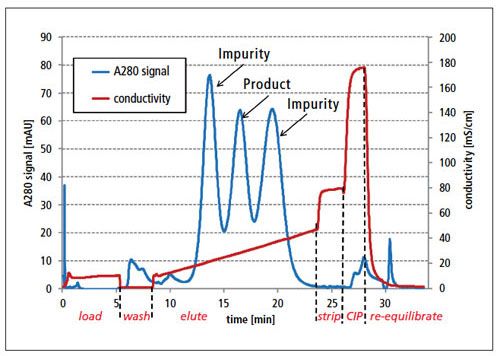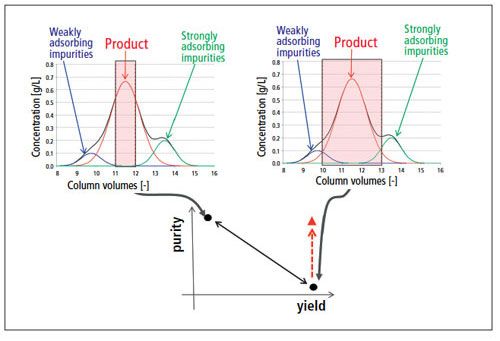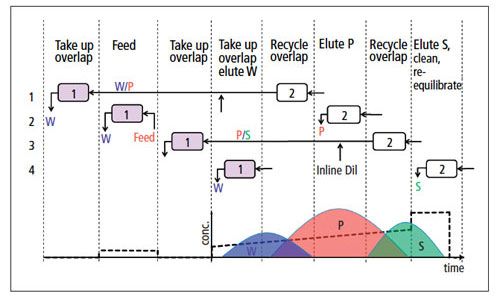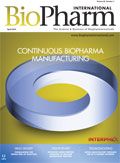Twin-Column Cation-Exchange Chromatography for the Purification of Biomolecules

In downstream processing of many biopharmaceuticals, cation-exchange chromatography is a key technology for the removal of product-related impurities such as fragments, aggregates, and undesired isoforms. When using traditional-batch chromatography, however, sufficient product purity can be achieved only at the cost of yield as the product-related impurities have similar adsorptive properties as the target molecule. This yield-purity trade-off can be resolved using twin-column counter-current cation exchange chromatography, which leads to simultaneous achievement of high product purity and yield. This article recapitulates the basics of cation-exchange chromatography and presents recent polishing case studies including bispecific antibodies and conjugated proteins.
The mechanism of separation in ion-exchange chromatography is based on charge interactions between the molecules to be separated and the ionic ligands attached to the surface of the resin particles. In cation exchange, the active ligands carry negative charges. One can distinguish “strong” and “weak” cation-exchange resin. The ligands of “strong” cation exchange resins correspond to strong acids (low pK
a
value) carrying a negative charge over a wide range of pH values used in downstream processing of biologics. In contrast, the ligands of weak cation exchange resins may be protonated (high pK
a
value) depending on the buffers used in the downstream processing. Essentially, this means that weak cation-exchange resins may exhibit buffering properties, which in many cases are undesired as they complicate process design. Strong cation-exchange resins, therefore, are used more often in preparative applications. The most common ligands in strong cation-exchange chromatography are sulphonate-based ligands. These ligands exhibit an excellent chemical stability allowing sanitization even with 1 M NaOH for multiple cycles without significant loss of capacity. The cation-exchange ligands are linked to the resin particles using a linker, which usually contains aliphatic and/or polar elements. Commonly used resin particle materials (also referred to as resin matrix) are made of polymeric or agarose-based components. The resin matrices have different properties with regard to mechanical strength, polarity, pore size, and structure. Ultimately, ligands, linkers, and resin matrix contribute to the adsorptive properties of the resin.

Theoretically, to adsorb on a cation exchanger, the target biomolecule needs a positive net charge. To achieve a positive net charge, the process should be operated at a buffer pH value below the isoelectric point of the biomolecule. As a rule of thumb, the buffer pH should be one to two units below the isoelectric point of the molecule and the ionic strength of the binding buffer should be low (preferably below 50 mM salt) to ensure that the protein is adsorbed with a decent binding capacity. If run under these conditions, dynamic capacities of 50 grams of protein bound per liter of stationary phase are not uncommon. The high binding capacity allows product concentration that is beneficial to reduce processing volumes further downstream. Most commercially produced antibodies have isoelectric points of pl 8–9. They can be easily adsorbed on the cation exchange resin in the presence of phosphate or acetate buffers with buffer capacity in the range of pH 4–7. Elution from cation-exchange chromatography is typically done using a salt gradient or a pH gradient, leading to desorption by competition or by charge repulsion, respectively. A representative example cation-exchange chromatogram is shown in
Figure 1
.
In addition to resins utilizing only cation-exchange functionalities, multi-modal resins are available, combining cation exchange and hydrophobic interaction principles. Cation-exchange chromatography is used in many cases in the downstream processing of monoclonal antibodies (mAbs) for aggregate removal following the Protein-A capture step and the low-pH hold virus inactivation step. It also clears host-cell proteins, although it is generally to a much lower extent than affinity chromatography. Cation-exchange chromatography is also suited to remove inactive protein variants and fragments, and can also be combined with multi-column chromatography to become a powerful tool for the purification of next-generation biologics.
Cation-exchange multi-column chromatography for next-generation antibody therapeutics
In recent years, a small number of antibody-drug-conjugates (ADCs) (such as Adcetris [brentuximab vedotin] and Kadcyla [ado-trastuzumab emtansine]) and bispecific antibodies (bsAbs) (such as Removab [catumaxomab]) have reached the markets. Many more are in clinical trials, as these compounds have promising applications in various therapeutic fields including oncology and anti-inflammatory treatments.
Depending on the upstream production technology used for the manufacturing of these next-generation biologics, the product compound of interest is usually accompanied by product-related impurities. In the case of ADCs, these impurities could be products with a undesired drug-antibody-ratio (DAR), and in the case of IgG-type bsAbs, the parental monoclonal antibodies (homodimers) could be the impurities. Downstream processing of next generation biologics is, therefore, likely to require a robust step capable of removing such product-related impurities, preferably along with aggregates and fragments.

Traditional cation-exchange chromatography faces a yield-purity trade-off when confronted with difficult separations such as removal of product-related impurities. The trade-off occurs due to the overlap of product and impurity peaks present when eluting the product. Choosing a narrow center product fraction excludes impurities in the product peak front and tail, leading to high product purity but low yield, while widening the product fraction leads to a high yield but a low purity (
Figure 2
).
Multi-column counter-current solvent gradient purification (MCSGP) has been introduced as a powerful chromatographic method to resolve this challenge and to deliver product with high yield and purity simultaneously (1). In its twin column embodiment, the process uses two chromatographic columns. Essentially one of the columns runs a batch gradient chromatography run. When the overlapping fraction of product and early eluting impurities is eluted from the column, however, a connection is made between the two columns and the overlapping fraction is internally recycled into the second column with in-line dilution in-between to ensure re-adsorption on the second column. The columns are disconnected for product recovery and re-connected again for internal recycling of the overlapping fraction of the product and the strongly adsorbing impurities. For cleaning and re-equilibration, the columns are disconnected again. The columns switch tasks and are operated in a cyclic manner so that the strain on the columns is the same. A process schematic is provided in
Figure 3
.
Due to the cyclic operation, the process lends itself to the application of process analytical technology (PAT) such as cycle-to-cycle process fingerprinting. The basis for MCSGP process design is a single column batch chromatogram that has been fractionated and analyzed to confirm the distribution of the product and the impurities. MCSGP utilizes the same buffers and resins as traditional batch chromatography.
Case studies
MCSGP mode has been demonstrated for purification of bsAbs and conjugated antibodies. In the bsAb case, MCSGP was used instead of single-column batch chromatography to isolate the main isoform of a bispecific antibody that was accompanied by other bsAb isoforms and the parental mAbs (1). The system used included a Poros 50HS (Life Technologies) strong cation-exchange resin and phosphate buffers (pH 6.0) with salt-gradient elution. Compared to batch chromatography, the cation exchange step yield could be improved from 37–87% for the desired impurity limits of <0.5% parental mAb main isoform content. This yield increase shows the enabling features of MCSGP that lead to a valid production scenario. Moreover, the study demonstrated that a preparative resin (50 μm particle diameter) could be used with high yield in an application that would require, in single column batch mode, an analytical stationary phase (with much smaller particles of <20 μm diameter) to obtain a comparable yield at comparable throughput. This feature is due to the capability of MCSGP to handle overlaps between product and impurities, which are frequently observed with preparative, large particle chromatography resins due to mass transfer limitations that are higher with larger particle sizes.

In a second case study, MCSGP was used to isolate a fraction of a model-conjugated antibody, mimicking Roche’s Kadcyla (2). Trastuzumab emtansine is produced by coupling the drug payload to free amino groups in the protein, giving rise to a broad DAR distribution of 0–8 payloads in the coupling reaction product (3). In this case study, a fraction corresponding to DAR=2 was isolated using cation-exchange MCSGP from a conjugation-reaction mixture of trastuzumab and a fluorescent dye, representing the drug payload. In the process, the same buffers and resin as in-batch chromatography were used. The chromatography step yield in comparison to single column batch was significantly increased from 34% to 61%, respectively. Narrowing down the DAR distribution of ADCs leads to products with an improved safety and efficacy profile.
In another case study, cation-exchange MCSGP was successfully used to isolate certain charge isoforms of monoclonal antibodies with high yield, similar as in the bsAb case (4). Charge isoforms of mAbs are generated mainly during the upstream fermentation process as a result of post-translational modifications. It is known that charge isoforms display different activities so isolating certain isoforms may be an interesting concept in the context of manufacturing of biobetters. Also for the production of biosimilars, tuning the mAb charge isoform profile may be of interest. Using spiked feed materials, it was shown that the MCSGP downstream process could “iron out” variations in the charge isoform profile that had been caused further upstream.
During product development, isolation of the mAb isoforms in sufficient quantities is required for characterization purposes (e.g., for cell-based assays). Also for this application, MCSGP is a useful tool because it can be easily automated, replacing dozens of HPLC runs with manual handling.
Summary
Cation-exchange chromatography is an integral part of many chromatographic downstream processes. It is a key technology for the removal of product-related impurities such as aggregates. Cation-exchange resins exhibit a high degree of chemical stability towards harsh cleaning regimes. If run under the appropriate conditions in terms of pH and ionic strength, they can bind their targets with high capacity. Predominantly, cation-exchange resins are operated in bind/elute mode with salt or pH gradients; operation in flow-through mode is much less common.
In combination with multi-column counter-current chromatography (MCSGP), the full potential of cation-exchange chromatography can be unlocked also for challenging separations such as bispecific antibody, ADC, and mAb isoform purifications. A twin-column MCSGP process is sufficient to suspend the yield-purity trade-off that is inherent in single column batch chromatography when working on challenging separations.
About the Authors
Thomas Müller-Späth, Nicole Ulmer, Lars Aumann, Claire Kennedy, and Michael Bavand are all from ChromaCon AG, Technoparkstrasse 1, 8005 Zurich. ALL FIGURES ARE COURTESY OF THE AUTHORS
References
1. T. Müller-Späth et al.,
BioProcess Internat.
11 (5), pp. 36–45 (May 2013). 2. T. Müller-Späth et al., "Obtaining a homogenous antibody-drug conjugate (ADC) using high resolution MCSGP chromatography,” presentation at PEGS conference (Boston, MA May 5th–9th, 2014). 3. M.T. Kim et al.,
Bioconjug. Chem.
25 (7), pp.1223–1232 (2014). 4. T. Müller-Späth et al.,
Biotechnol. and Bioeng.
107 (4), pp. 652–662 (2010).
Article Details
BioPharm International
Vol.
28
, No. 4 Pages: 32–36
Citation
: When referring to this article, please cite it as T. Müller-Späth et al., “Twin-Column Cation Exchange Chromatography for the Purification of Biomolecules,”
BioPharm International
28
(4) 2015.

Tokyo University of Science Research Team Explores Improved Delivery of Antisense Oligonucleotides
April 18th 2025Using cholesterol-modified oligonucleotides, the research team aims to improve the delivery of antisense nucleotide-based therapies for treating neurodegenerative diseases and brain cancers.